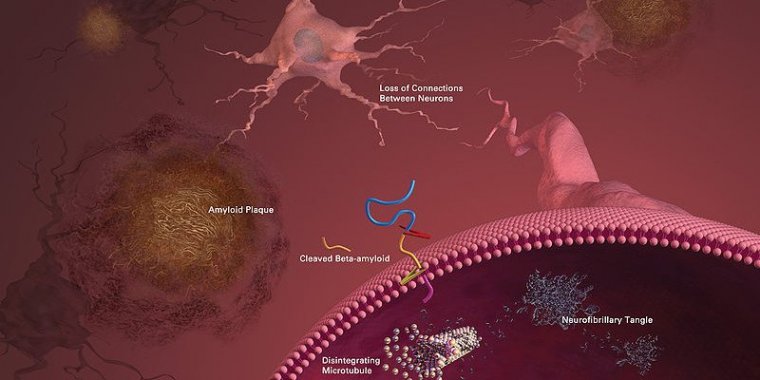| Health / Health News |
NIH scientists search for the clocks behind aging brain disorders
To understand the link between aging and neurodegenerative disorders such as Alzheimer’s disease, scientists from the National Institutes of Health compared the genetic clocks that tick during the lives of normal and mutant flies. They found that altering the activity of a gene called Cdk5 appeared to make the clocks run faster than normal, and the flies older than their chronological age. This caused the flies to have problems walking or flying later in life, to show signs of neurodegeneration, and to die earlier.

Characteristics of Alzheimer's disease. Image credit: National Institute on Aging.
On average, the normal flies in this study lived for 47 days. To create a genetic clock, the team measured the levels of every gene encoded in messenger RNA molecules from cells from the heads and bodies of flies at 3, 10, 30, and 45 days after birth.
This allowed the researchers to use advanced analysis techniques to search for the genes that seemed to be sensitive to aging, and create a standard curve, or timeline, that described the way they changed.
When they performed the same experiments on 10-day-old mutant flies and compared the results with the standard curve, they found that the flies were “older” than their chronological age. Altering Cdk5 activity made the brains of the flies appear genetically to be about 15 days old and their bodies to be about 20 days old.
Cdk5 is a gene that is important for the normal wiring of the brain during early development and may be involved in some neurodegenerative disorders, including ALS, Parkinson’s and Alzheimer’s disease. Eliminating or increasing Cdk5 activity beyond normal levels shortened the lives of the flies to about 30 days.
After 10 days of age, the manipulations reduced the distance flies could climb up tubes and the alterations caused older flies to have signs of neurodegeneration, including higher than normal levels of brain cell death and degradation.
Altering Cdk5 activity changed the level of several groups of genes that were also affected by aging, including those that control immunity, energy, and antioxidant activity.
The researchers tested the strength of the flies’ antioxidant defenses against toxic versions of several chemicals found in cells called oxygen free radicals. Initial experiments showed that aging reduced these defenses in normal flies.
Three-day-old healthy flies lived for about 100 hours after exposure to free radicals, and that time decreased with age. In contrast, the defenses of Cdk5 mutant flies were even weaker as they died sooner than the control flies at all ages.
The results suggest that aging may not just predispose an individual to degeneration, as we thought. Acceleration of aging may actually be part of the mechanism by which degenerative disease disrupts the structure and function of the brain. (National Institutes of Health)
YOU MAY ALSO LIKE





